Forthcoming Events and Activities
- Keep up to date on our new Facebook Page
 The Ball Clay Heritage Society now has a Facebook Page – take a look and share photos from our archive, up-to-date news, join in conversations – and much more at www.facebook.com/BCHS.2000.
The Ball Clay Heritage Society now has a Facebook Page – take a look and share photos from our archive, up-to-date news, join in conversations – and much more at www.facebook.com/BCHS.2000.s
s
- Clay HUGS – A gift from the Bovey Basin
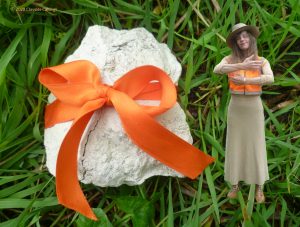
Clay HUGS – A gift from the Bovey Basin during Lockdown 2020
by Dr Lu La Buzz
HUGS is a special type of clay known only to clay workers in the Bovey Basin. It occurs where two distinct seams of Ball Clay merge together and become one. The clay HUGS featured above, which I have dressed in orange ribbon to match my safety jacket, was presented to me by quarry manager Darrin Hewings, during a visit to Southacre Quarry last year. Whist onsite Darrin, who is a 5th generation clay cutter, also demonstrated the official sigh for HUGS which can be ‘read’ by quarry workers over long distances.
In our current times of lockdown and social isolation, this extraordinary clay – lovingly named HUGS – is a reassuring emblem of strength, compassion and unity.
Darrin and his present team of clay cutters have continued to dig clay throughout lockdown, but will close for a week in May to rest and spend time with their families.
Warm wishes to all. Take care and stay well,
Lu La
Dr Lu La Buzz
Artist, Educator and Champion of ClayWith special thanks to Darrin Hewings of Sibelco for sharing his industrial knowledge.
- 2020 AGM
THE 2020 AGM due to be held on Wednesday 18th March 2020 HAS BEEN POSTPONED because of the risks associated with the Corona Virus
The date of the postponed meeting will be notified in due course
- The Friendly Clay Wagon
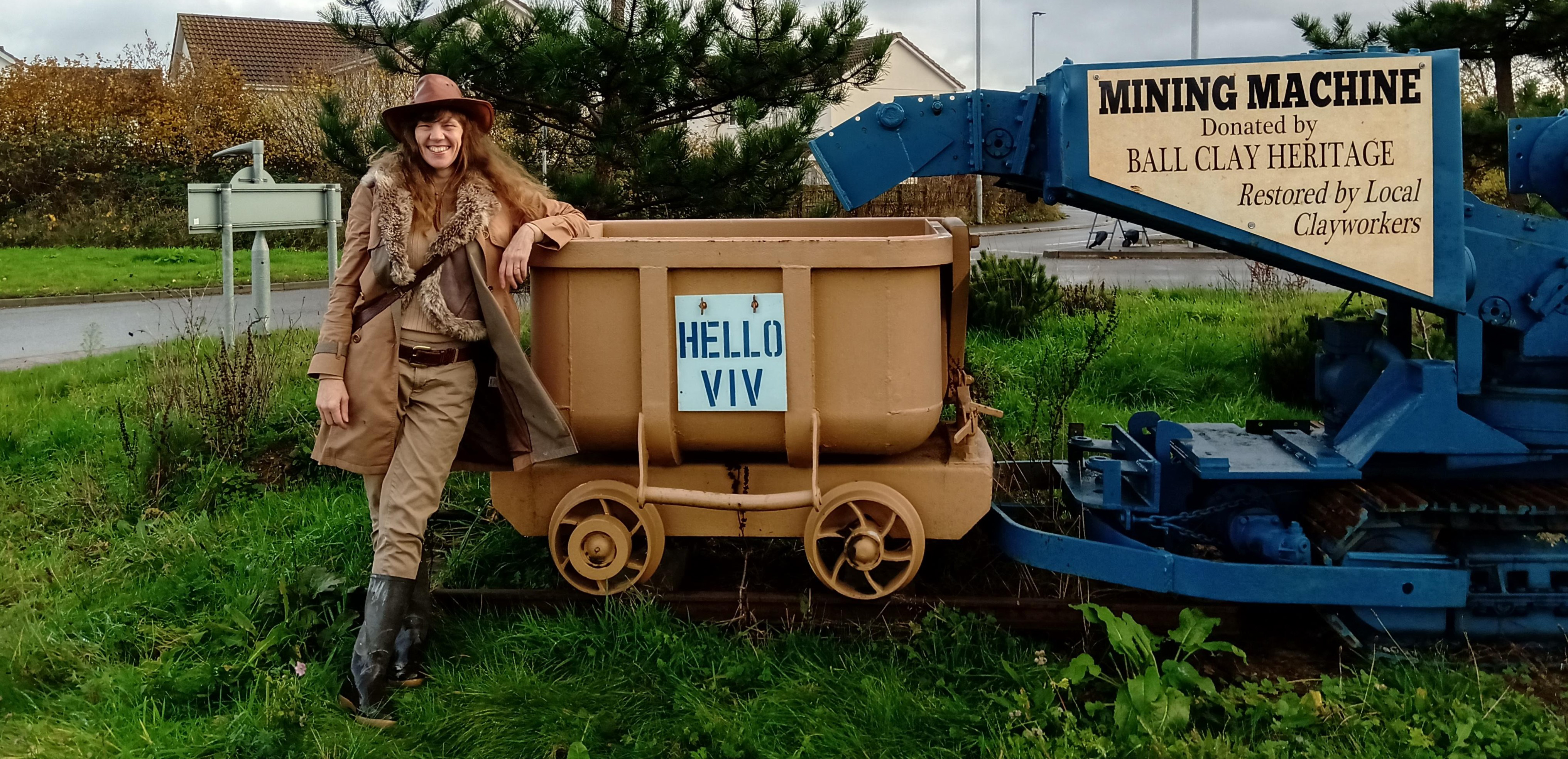
The Friendly Clay Wagon – An introduction by Dr Lu La Buzz
This lovingly restored clay wagon has become a popular landmark in Kingsteignton. After many years of underground service, the wagon (which retired in 1999) is now permanently installed on the roundabout at Clay Pits Way. The wagon’s endearing messages – which change periodically – are a source of delight and amusement for local folk. Whilst working underground in the later part of the last century, these messages would have been functional, to indicate clay type (DA for ‘Dark Alum’ or LB for ‘Light Blue’ as pictured below), but today the messages are purely social; a cheery greeting for local resident Auntie Viv for example.
The wagon first appeared on the roundabout in 2017, and was later joined by an underground mining machine, both of which were restored by local clayworkers. Standing side by side as they now do, the wagon and accompanying mining machine replicate their original assembly underground, with the clay feeder positioned above the wagon.
As a lover of all things clay, I visit the wagon on a regular basis, and am always thrilled to see a new message or dedication. Nick-names, celebratory greetings and football related initials (specifically Liverpool) often appear. Darrin Hewings, who organised the installation (and is responsible for the codes and messages) has plans to install a third piece of machinery, of which I will keep you informed. In the meantime drive by – visit the wagon and experience an open-air tribute to the history of underground mining.
If you would like a message displayed on the wagon please contact us: claysidecallings@zoho.com
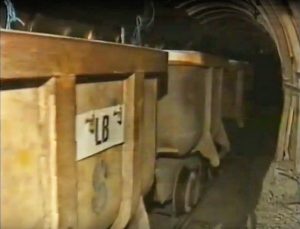
Wagons on their way down the mine. The initials LB – ‘Light Blue’ denote clay type.
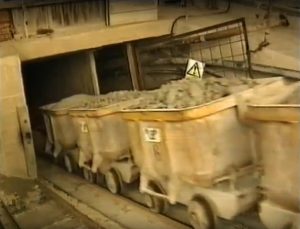
The same wagons return to the surface laden with ‘Light Blue’ clay.
Stills from YouTube film: Underground Mining by machine – WBB Adit 11 Mid 1990s
Dr Lu La Buzz
Artist, Educator and Champion of Clay
Clayside CallingsWith special thanks to Quarry Manager, Darrin Hewings for sharing his industrial knowledge and expertise.
- Wild Clay Wednesdays – Summer 2019
Wild Clay Wednesdays – Summer 2019
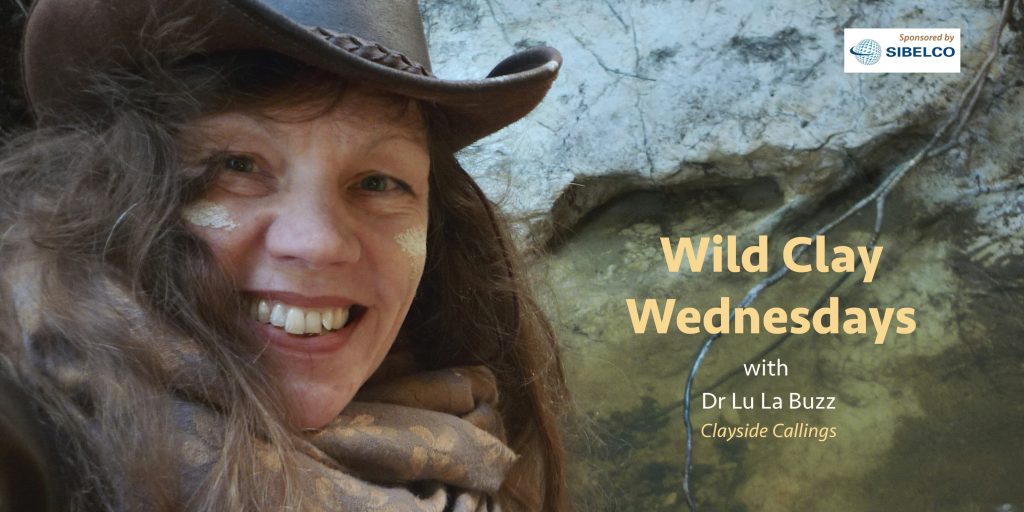
Review by Dr Lu La Buzz
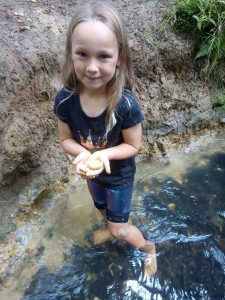
This summer I led a series of creative clay walks at Stover Country Park. They were a huge success. We had plenty of bookings with numbers growing week by week – undoubted proof that people want to learn more about Ball Clay. The hands-on nature of the sessions appealed to all ages. Young children attended with parents and grandparents – all of whom became playfully engaged with the clay.
For many participants, this was the first time they’d experienced clay on-site in its natural habitat. It was a joy to see them seek-out and harvest their own piece of Ball Clay. Hand pinched faces and forms naturally emerged as participants responded to the clay’s soft transformative nature. Some participants chose to create ephemeral art which they left onsite, whilst others took their work home with them, as a lasting momento of their experience. It was a powerfully tactile experience for all, and an
honour for the clay to be acknowledged in this way.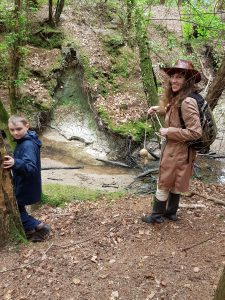 A good majority of attendees lived in Bovey Tracey, others traveled from Teignmouth, Totnes and Plymouth. As well a young sparky children we had specialists in geology, geography, as well as creative practitioners and teachers. As evidenced below, participants thoroughly enjoyed the sessions and felt enriched by their wild clay encounter.
A good majority of attendees lived in Bovey Tracey, others traveled from Teignmouth, Totnes and Plymouth. As well a young sparky children we had specialists in geology, geography, as well as creative practitioners and teachers. As evidenced below, participants thoroughly enjoyed the sessions and felt enriched by their wild clay encounter.“Such creative magic occurred between the group as we stepped into the stream barefoot and took that amazing clay in hand. X“
Emma (participant, Totnes)“Lu La is very passionate about clay and educating others about it. The walk was fascinating, engaging, creative and Magickal. We will be coming along to more of her events in future!”
Claire (participant, Newton Abbot)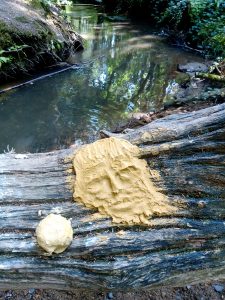 I will be running further sessions during Autumn half term and Spring/Summer 2020. For further information please visit: http://claysidecallings.eventbrite.com
I will be running further sessions during Autumn half term and Spring/Summer 2020. For further information please visit: http://claysidecallings.eventbrite.comDr Lu La Buzz
Artist, Educator and Champion of Clay
Clayside CallingsWith special thanks to Sibelco for sponsoring these events and Stover Country Park for granting permission to run them.
- Chairman’s Annual Report, 2019
BALL CLAY HERITAGE SOCIETY
Twentieth Annual General Meeting: 12 March 2019
CHAIRMAN’S ANNUAL REPORT
Welcome to the 20th AGM of the Ball Clay Heritage Society.
As usual I would like to update you with what the Society has been doing over the last twelve months.
The General Committee met in July and November. There has been no change in the members of the Committee. However we have been saddened by the death in December of George Copp who had been manager of the North Devon Clay Company. He was a highly respected member of the local community and an invaluable source of information on the history of ball clay industry in North Devon.
At our last AGM the Revd. Nicholas Pearkes gave a splendid talk on the Lost Mine of Penn Recca and the Lost Canal of Littlehempston, which was a lesson in how a once thriving mining concern could vanish almost without trace. In May Richard Harris gave us a very interesting talk on the Hackney Canal and Quay. Unfortunately there are not too many traces left of those facilities either. We had hoped to organise another visit in the autumn to Wolf Minerals tungsten mine and processing facility but the company has gone into administration and it too seems to be going the same way as the Lost Mine of Penn Recca.
Luckily the ball clay industry is far from disappearing! In July a group of members were given a tour of Sibelco’s Preston Manor a
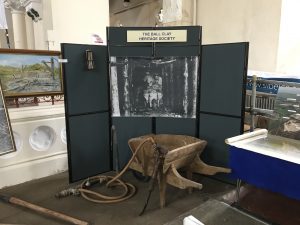
The Wheelbarrow exhibited at St Leonard’s Church (future Newton’s Place), Newton Abbot in June 2017
nd East Golds works and were very impressed by the dramatic expansion of the pits at Preston Manor following the closure of the Chudleigh Road. Last year Darrin Hewings organised one of our steel underground mining wagons to be placed by Sibelco on the ‘Clay Pits’ roundabout, and he has now added our underground mining machine which he arranged for volunteers to re-assemble. I think the installations have made quite an impact.
An earlier piece of equipment used underground was the humble wheelbarrow and we have been given by Teignbridge District Council the wheelbarrow that Simon Cunningham, a former TDC ranger, reconstructed from the iconic image of Geoff Gibbs and Les Bickham working in Bill Tribble’s shaft in the early 1950’s. In recent exhibitions we have used the wheelbarrow, a pneumatic spader and other artefacts in conjunction with a large reproduction of the iconic image to give a strong impression of conditions that used to exist underground.
We would like to reconstruct the ‘crab’ mining headgear that used to be at the Abbrook social club and is characteristic of South Devon ball clay, but we are currently lacking details of its original dimensions.
The Society’s archive collection has been considerably enhanced during the past year by the important donation by Sibelco of 16 boxes of Watts Blake Bearne title deeds which the company no longer requires because all its titles have now been registered. The deeds relate to dozens of parcels of land in Kingsteignton and Newton Abbot and are of considerable local historical interest. I am familiar with most of them as one of my first jobs when I joined the company in the 1970’s was to go through them all and fit together the ‘jigsaw’ of the company’s landholdings. Particularly valuable are a couple of boxes of very old deeds going back to the end of the 18th and early 19th centuries, which I believe no one has seen in recent times. Some relate to the earliest clay merchants and the partnership formed by Agnes Watts, William Mortimer, Samuel Whiteway and John Hatherly, that was based partly on land at Abbrook acquired in the 1820’s from the financially stretched George Templer.
Other acquisitions during the past year were four bricks produced by the Marland Brick and Clay Works in the 19th century, presented to the Society by Michael Messenger, and a very fine painting of a vessel called the ‘Bonawe’ loading ball clay at Poole quay from a barge moored alongside – the same system that was used for transferring clay from barges to vessels in Teignmouth Harbour. The painting was made in the 1920’s and as far as I know it is the only known work of art depicting the transport of ball clay.
Conversion of the former St Leonard’s church in Newton Abbot to ‘Newton’s Place’ is well in hand. Discussions have been held with Felicity Cole, the museum curator, on what items from the Society’s collections could be included in a ball clay exhibit there on a more or less permanent basis, and she is considering this with the designers. She is offering the Society the opportunity to mount a temporary exhibition in August 2020 in rooms that at other times of the year will be used by the Town Council. Unfortunately there will be insufficient space in Newton’s Place for the Society’s archive collection that is currently in the cellar of my house. However on a visit by Bryn and me to Devon Heritage Centre in November it was confirmed that the Centre was willing to accommodate the collection, although I suspect that they may be selective in what they take. Photographs could also be accommodated but the Society’s artefacts would have to go to Newton’s Place.
The Devon Remembers project was completed last year with the publication of the book “Devon During the First World War” containing 22 chapters summarising the individual research projects, including one on the ball clay industry put together by John Ellis, Richard Harris and myself. The leader of the Devon Remembers project, Katherine Findlay, published her book on “The Icelandic Adventures of Pike Ward” based on the diaries of the 19th century founder of the Teignmouth shipbroker of the same name. During his long visits to Iceland his redoubtable mother Elisa ran the shipbroking business. Katherine found in our letter books much friendly correspondence between Elisa and Charles Blake of Watts Blake Bearne, and I understand that Lou Bagnold, the chair of Teignmouth and Shaldon museum, intends to make use of it in a book that she is planning to write about Elisa Ward – who, incidentally, was a Pike from Chudleigh and was probably related to the Pike from Chudleigh who founded Pike Brothers, the Dorset ball clay producer.
Steve Carreck is making slow but steady progress with the conversion of our www.clayheritage.org website to WordPress. The website continues to generate interest and enquiries – such as from the American asking who he should contact in the USA to obtain ball clay for making clay tobacco pipes. We would like a volunteer to take on the job of managing the website and we have not yet manged to restart the publication of our newsletter or the formal cataloguing of our photographs following the sad loss of Tony Vincent. However Darrin has organised regular sessions with retired clay workers to go through our photographic collection and identify people and places appearing in them. Darrin and Bryn have given a number of talks to local groups on the history of the ball clay industry.
We welcome your comments and suggestions regarding what the Society does or should do. We would especially like your views on future talks and outings. Anyone interested in researching or just browsing through our collections of archive material and photographs will always be very welcome at Dunderdale Lawn.
– John Pike
Chairman
12 March 2019 - Haytor Granite
“Haytor Granite” by Stuart Drabble
At the 2019 AGM, Stuart Drabble, former bursar of Stover School, gave a very interesting talk based on his important new book “Haytor Granite” that was published in January.
The book describes the businesses set up by George Templer of Stover and his successors to produce the granite, its transportation via the Haytor Granite Railroad, Stover Canal and Teignmouth Quay for its use in London Bridge and many famous buildings and monuments. The book is very thoroughly researched and contains many photographs illustrating the very readable text.
Find out more about the book in The Dartmoor Magazine.
- Recent Additions to our Collections
Recent Additions to our Collections
The Society is pleased to have received a number of items to add to its collections, including the following:
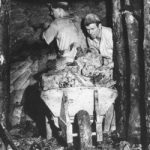 A reconstruction of the type of Wheelbarrow used in underground shafts in South Devon until the early 1950’s. This was made by Simon Cunningham, a former Teignbridge ranger who was responsible for the visitor centre at Decoy Country Park, the site of the former Devon & Courtenay clay works, and it was part of a small exhibition relating to the old clay workings. Simon’s only guide as to the construction of the wheelbarrow was the attached photo showing Geoff Gibbs and Les Bickham in Bill Tribble’s shaft in Southacre, Preston Manor, Kingsteignton in 1951. The wheelbarrow has been donated to the Society by Teignbridge District Council.
A reconstruction of the type of Wheelbarrow used in underground shafts in South Devon until the early 1950’s. This was made by Simon Cunningham, a former Teignbridge ranger who was responsible for the visitor centre at Decoy Country Park, the site of the former Devon & Courtenay clay works, and it was part of a small exhibition relating to the old clay workings. Simon’s only guide as to the construction of the wheelbarrow was the attached photo showing Geoff Gibbs and Les Bickham in Bill Tribble’s shaft in Southacre, Preston Manor, Kingsteignton in 1951. The wheelbarrow has been donated to the Society by Teignbridge District Council.
- Sixteen boxes of title deeds of the Devon properties of Watts, Blake, Bearne & Co. presented to the Society by Sibelco UK, being superfluous to the company’s needs following the registration of the titles. The deeds are of considerable local historical interest, relating as they do to the many properties in Kingsteignton and Newton Abbot that were acquired by WBB & Co. subsequent to the establishment of the partnership in 1861. Two boxes contain deeds of the earliest clay partnerships of the late 18th and early 19th centuries. It appears that they have not been accessed for a considerable time, and may well cast new light on the early history of ball clay working in the Bovey Basin.
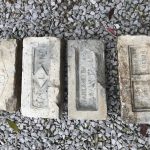 Four different Bricks produced by the North Devon Clay and Brick Works in the late 19th century, each stamped with a different company stamp; presented by Michael Messenger, the author of ‘North Devon Clay’.
Four different Bricks produced by the North Devon Clay and Brick Works in the late 19th century, each stamped with a different company stamp; presented by Michael Messenger, the author of ‘North Devon Clay’.
- An original Painting entitled “The Bonawe loading China Clay at Poole”. The painting depicts the coaster ‘Bonawe’ alongside Poole Quay (with Poole Pottery chimneys in the background) and a barge alongside it from which clay is b
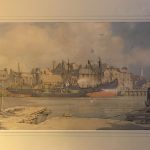
The ‘Bonawe’ loading ball clay from a barge alongside, Poole Quay, c.1920’s
eing loaded in baskets onto the vessel. The ‘clay’ must actually have been ball clay that had been transported in the barge across Poole Harbour from the Wareham basin ball clay works. The painting shows white dust emerging from the hold suggesting that the clay must have been very dry and powdery! The same method of transferring clay from barge to sea-going vessel was employed at Teignmouth, often with the vessel moored in the harbour. The ‘Bonawe’ was owned and operated by J & A Gardner & Co. Ltd. of Glasgow, shipowners and operators of the Bonawe stone quarry on Loch Etive. The painting, which is very fine, was probably made in the 1920’s and is a rare example of a work of art depicting the production or transport of ball clay. The artist, Maurice Clarke, may have been an art teacher at Repton and Harrow schools.
- Chairman’s Annual Report 2018
BALL CLAY HERITAGE SOCIETY
Nineteenth Annual General Meeting: 13 March 2018
CHAIRMAN’S ANNUAL REPORT
Welcome to the 19th AGM of the Ball Clay Heritage Society.
As usual I would like to update you with what the Society has been doing over the last twelve months.
The General Committee met in July, October and February. The only change in the membership of the committee was the resignation of Cllr Chris Meathrel, who had been nominated as a committee member by Kingsteignton Town Council, and his replacement by Cllr Bill Thorne, whom we are very pleased to welcome to the Committee.
At our last AGM we had a very interesting talk by Helen Turnbull on “The Cliffords of Ugbrooke Park”, reminding us that various generations of the family were rather distinguished and important for reasons other than their clay leases and the collection of dues paid by the ball clay merchants for their use of the Hackney Canal.
In June last year we mounted an exhibition in Newton’s Place – the former St Leonard’s Church – for an open day when members of the public could view the building and see the preliminary plans for its conversion into the Town museum and community centre. The Newton’s Place project is progressing and we are hopeful that there will be space in the final layout for a permanent display relating to the ball clay industry. We have been approached by Devon Archives in Exeter as to the future storage of our archive material and collection of photographs, but our preference is for these to be kept in Newton Abbot if possible. There is a debate about whether the organ should be retained in Newton’s Place, but this would significantly reduce the space for the storage of archive material and historic objects that could not otherwise be kept.
In September we had a display at the Stover Canal Trust open weekend. We made use of the ‘pop-up museum’ that was created as part of a project by Johanna Korndorfer and Mandy Biscoe a few years ago. It doesn’t exactly ‘pop-up’ and in fact it’s rather heavy but it has some good features. We have now taken possession of it.
As I am sure most of you have seen, Darrin Hewings has arranged for one of our steel underground mining wagons to be placed on the roundabout at the beginning of Clay Pits Way, displaying mystery numbers that change from time to time! He has also organised the re-assembly of the Fuchs underground mining machine which he is going to place on the roundabout as if it is feeding clay into the wagon. I am not sure how far Devon Highways tolerance stretches, but ultimately it is hoped to place some steel arches over the wagon and mining machine so that motorists can enjoy an open air mining museum as they drive around the roundabout.
I am pleased to say that the ‘Devon Remembers’ project on the local ball clay industry in the First World War was completed in December. This involved a lot of research by Richard Harris, John Ellis and myself into local newspapers, military tribunal reports and thousands of pages of correspondence contained in the Watts Blake Bearne letter books of the period. The product of our work is a timeline in chronological order of 65 pages of extracts from those documents and a chapter for the book that is to be produced as the final stage of the Devon-wide project. Apart from the main stories such as the calling up of clay workers and the consequences of the sinking by German submarines of many cargo vessels, it was fascinating to read the correspondence between CD Blake –- who was then aged about 80, the much respected senior partner with 55 years’ knowledge of the business, but completely blind and dictating a stream of letters by phone to Park House from his house Highgrove, a young Mr William Watts who went off to serve in Palestine and Arthur Bearne who with a handful of office staff was keeping the business going but regularly pressing Mr Blake to agree to pay another dividend.
We have provided our Devon Remembers project material to some local schools and hope thereby to generate more interest in the history of the ball clay industry. Darrin is also doing an excellent job giving talks on the history of the industry to local groups.
At the end of February Jane Chilvers of Sibelco opened up her secret store at Preston Manor of documents that she rescued from Park House when the office was closed in 2001, and I have selected a number of files and ledgers, including some very interesting records of plant and other assets, which I have added to our archive collection.
We are still very much missing the enormous contribution that Tony Vincent made to the Society. However I think we are getting closer to the point at which we will have volunteers who can resume the task of cataloguing out collection pf photographs. We are also looking for a new editor of our newsletter, Chris Meathrel having resigned.
Steve Carreck is making progress with the conversion of our www.clayheritage.org website to WordPress, which should make the content easier to manage, and has produced a number of revised pages for Committee members to review. We will need a volunteer to take on the job of managing the website and possibly also contributing photographs to the WBB Minerals Facebook pages.
Having almost exhausted our stock of our booklet “The Ball Clays of Devon and Dorset”, we have been able to purchase from Tor Mark another 150 copies, leaving only about 50 copies with Tor Mark.
Our social programme was confined to a very enjoyable skittles evening with Stover Canal Trust members in April, as unfortunately we were unable to follow up our very successful visit to Wolf Minerals tungsten mine at Drakelands in October 2016 with another Society visit. However Wolf Minerals have now themselves resumed public visits for individuals to join. We now have a talk by Richard Harris on the Hackney Canal and Quay arranged for 8thMay, and a visit to Sibelco’s South Devon ball clay works on 3rd July. We are also hoping to arrange a guided walk of the Stover canal with John Ellis to see the restoration work at Graving Dock Lock and Ventiford Basin.
The Teignmouth and Shaldon Museum continues to display several of the Society’s small artefacts in its ball clay industry display, and Newton Abbot Museum continues to display the Society’s Bronze Age spear head and some other objects.
We welcome your comments and suggestions regarding what the Society does or should do. We would especially like your views on future talks and outings. Anyone interested in researching or just browsing through our collections of archive material and photographs will always be very welcome at Dunderdale Lawn.
John Pike
Chairman
13 March 2018 - Chairman’s Annual Report 2017
BALL CLAY HERITAGE SOCIETY
Eighteenth Annual General Meeting: 9 March 2017
CHAIRMAN’S ANNUAL REPORT
Welcome to the 18th AGM of the Ball Clay Heritage Society.
I am sorry to report that we have suffered some sad losses in recent months. As I expect you are all aware, Tony Vincent passed away unexpectedly last October. After joining the Committee in 2005 Tony made a huge contribution to the Society, cheerfully taking on the tasks of developing our much admired website, cataloguing our photograph collection and editing our newsletter. His passing has revealed how much we owe to him. Another sad event recently has been the passing of Pat Proctor who with husband Reg has been a strong and active supporter of the Society for many years. And just last Friday Fred Cox passed away. He was a keen Society member who worked for WBB and, amongst other attributes, was a very talented artist and constructor of the Abbrook bowling green. I would like to ask you all to stand for a moment in memory of Tony, Pat and Fred.
I would like to update you with what the Society has been doing over the last twelve months.
The General Committee met in June, October and January. We are very pleased that Darrin Hewings , who is Sibelco’s South Devon quarries manager, joined the Committee at the last AGM. Individual committee members have, as always, been involved with quite a lot of activity, and I would like to take this opportunity to thank the committee members for their efforts on behalf of the Society during the year.
With regard to events, at our AGM in March 2016 Darrin stepped in to give us a very enjoyable talk on “Ball Clay Through the Ages”.
In October the Society had a really well organised visit to the Wolf Minerals tungsten operations at Drakeland hosted by former WBB employee, Tony Hearn, who is now a manager of the engineering company that installed the process plant. This is a huge project involving the investment of about £125 million and involves a very extensive process to extract just 0.17% of tungsten and 0.02% of tin from the millions of tonnes excavated each year. It was amazing to realise that this operation is a stone’s throw from Sibelco’s Headon china clay pit. As mentioned in the Notice of the meeting it may be possible to arrange another visit to Drakelands. If you are interested please let Geoff or Bryn know.
We are planning to organise a visit during this summer to Sibelco’s South Devon operations and a guided visit to see the restoration work on the Ventiford Basin and Graving Dock Lock on the Stover Canal in September, and other activities. As also mentioned in the Notice there will be a skittles evening with Stover Canal Trust members on 7th April. Those interested should contact Pauline Harrap.
During the year we continued to receive some additions to our collections. In May we were presented by Rob Harris with an ex-WBB battery charger unit for underground miners’ lamps. Beryl Vincent kindly donated Tony’s collection of books, maps, papers and other materials relating to the clay industry.
Until the day before he passed away Tony was continuing to make substantial progress in scanning and cataloguing our collection of prints and slide photographs. We are now looking for one or more volunteers who will take up this task using the Modes cataloguing software, ideally – but not necessarily – people who are familiar with the scenes in the photographs.
Similarly we are looking for someone to take on the management of our clayheritage.org website which is an important link for the Society with the outside world, containing as it does a great deal of information about the ball clay industry and generating enquiries relating to the history of the ball clay industry. Chris Meathrell has volunteered to edit the next version of the Society’s Newsletter
We had an interesting visit in July from Alan Denley, an old Newtonian whose interest in railways led him to old photos showing the Devon and Courtenay clay cellars near the old power station by the Town Quay.
The Society has taken on a project to research the impact of the First World War on the South Devon Ball Clay industry and the consequent impact on the communities of Kingsteignton and Newton Abbot. This is under the auspices of the Devon county-wide Heritage Lottery funded “Devon Remembers” project. Valuable research into local newspaper reports and military tribunals is being carried out by Richard Harris and John Ellis and I am researching our archive material relating to the First World War period with support from Geoff Hughes. The main stories concern the calling up of clay workers and the difficulties of supplying customers, especially because of the sinking by German submarines of many cargo vessels – several carrying clay from Teignmouth. We have been asked to contribute our research notes and exhibition texts and copy documents by sometime in 2018.
I mentioned last year that the Neighbourhood Development Plan for Newton Abbot advocated the provision of new premises for the Town Museum in the town centre. Things have now moved on and the Town Council has purchased the former St Leonard’s Church in Wolborough Street to house both the Museum and the Town Council under the title “Newton’s Place”. Discussions have been held with the Museum’s curator and we are hopeful that there will be space for a small permanent display about the ball clay industry. Whether there will be space to house at least part of the Society’s collections of archive materials and photographs remains to be seen.
The Teignmouth and Shaldon Museum continues to display several of the Society’s small artefacts in its ball clay industry display, and Newton Abbot Museum continues to display the Society’s Bronze Age spear head and some other objects.
As mentioned at last year’s AGM, Sibelco offered to house the Society’s mining equipment that was previously kept at the old carpenters’ workshop at Abbrook, in the old tyre workshop at Preston Manor. Darrin Hewings has since arranged for all the equipment to be moved to its new home. The most important piece of equipment is the Fuchs mining machine that was dis-assembled in the early days of the Society. This is now being re-assembled in the old fitters’ workshop at Preston Manor where there is suitable lifting gear – the Society’s mobile lifting device having disappeared from Abbrook. The work is being carried out by some of the current employees who are familiar with the machine when it was operating underground until 1999.
Darrin is arranging for one of the Society’s four steel underground mining wagons to be painted and installed at the roundabout at the Kingsteignton end of Clay Pits Way, as a symbol of the clay industry’s heritage.
I should mention that we have concerns about what has happened to Jimmy Samways whom many of us know from Society trips to Dorset. We understand that he has moved out of his home near Wareham where he had a substantial collection of artefacts from the Dorset ball clay industry. We think these would probably be best preserved by the Purbeck Mineral and Mining Trust.
The Society was represented with a stand at Volunteer Fairs organised by Teignbridge District Council at Forde House and Market Walk, and the Society has become a member of the Teignbridge Heritage Forum that emerged from the same initiative.
We welcome your comments and suggestions regarding what the Society does or should do. We would especially like your views on future talks and outings. Anyone interested in researching or just browsing through our collections of archive material and photographs will always be very welcome at Dunderdale Lawn.
John Pike
Chairman
7 March 2017